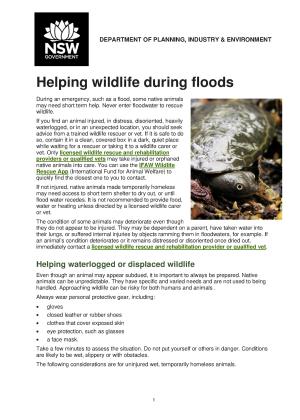If you find an animal injured, in distress, disoriented, heavily waterlogged, or in an unexpected location, you should seek advice from a trained wildlife rescuer or vet. If it is safe to do so, contain it in a clean, covered box in a dark, quiet place while waiting for a rescuer or taking it to a wildlife carer or vet. Only licensed wildlife rescue and rehabilitation providers or qualified vets may take injured or orphaned native animals into care. You can use the IFAW Wildlife Rescue App (International Fund for Animal Welfare) to quickly find the closest one to you to contact.
If not injured, native animals made temporarily homeless may need access to short term shelter to dry out, or until flood water recedes. It is not recommended to provide food, water or heating unless directed by a licensed wildlife carer or vet.
The condition of some animals may deteriorate even though they do not appear to be injured. They may be dependent on a parent, have taken water into their lungs, or suffered internal injuries by objects ramming them in floodwaters, for example. If an animal’s condition deteriorates or it remains distressed or disoriented once dried out, immediately contact a licensed wildlife rescue and rehabilitation provider or qualified vet.
Helping waterlogged or displaced wildlife
Even though an animal may appear subdued, it is important to always be prepared. Native animals can be unpredictable. They have specific and varied needs and are not used to being handled. Approaching wildlife can be risky for both humans and animals.
Always wear personal protective gear, including:
- gloves
- closed leather or rubber shoes
- clothes that cover exposed skin
- eye protection, such as glasses
- a face mask.
Take a few minutes to assess the situation. Do not put yourself or others in danger. Conditions are likely to be wet, slippery or with obstacles. The following considerations are for uninjured wet, temporarily homeless animals.
Considerations for uninjured wet, temporarily homeless native wildlife
| Type of animal | Considerations | What to do |
|---|---|---|
| Large mammals |
|
|
| Birds and small mammals (including possums and bandicoots) |
|
|
| Flying-foxes |
|
|
| Turtles |
|
|
| Snakes and lizards |
|
|
| Insects and spiders |
|
|
For information on deceased wildlife disposal see Helping wildlife in emergencies.


